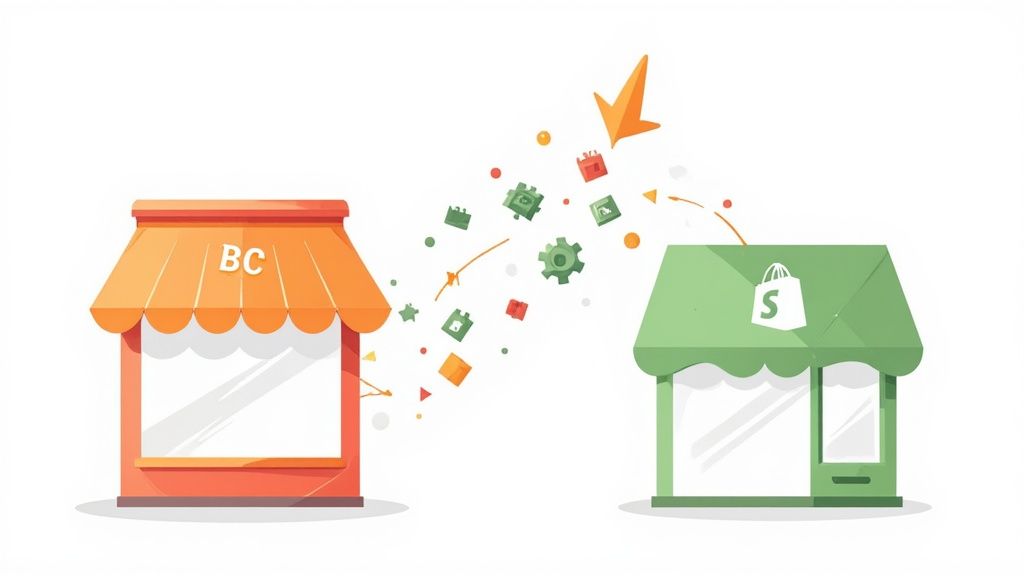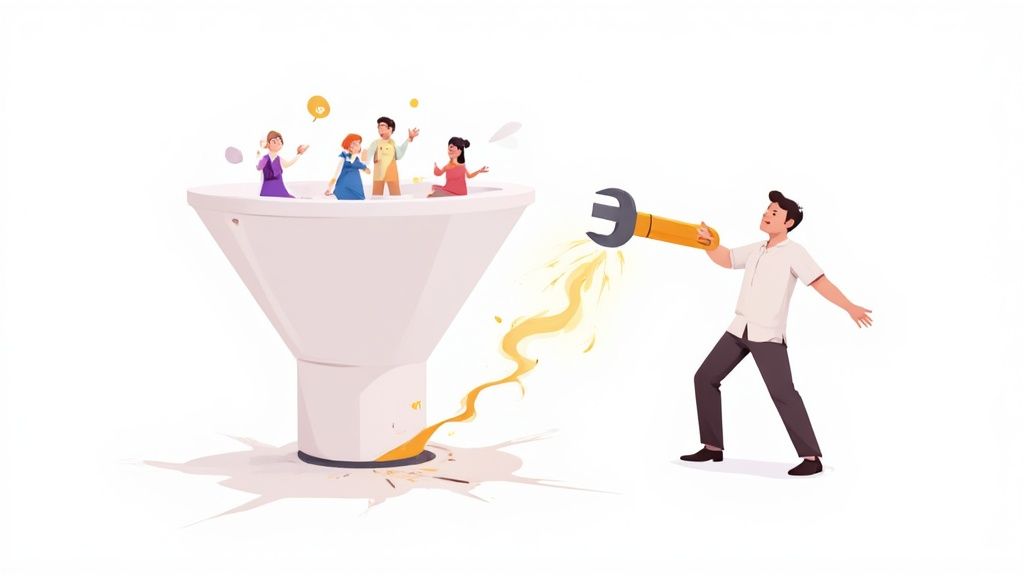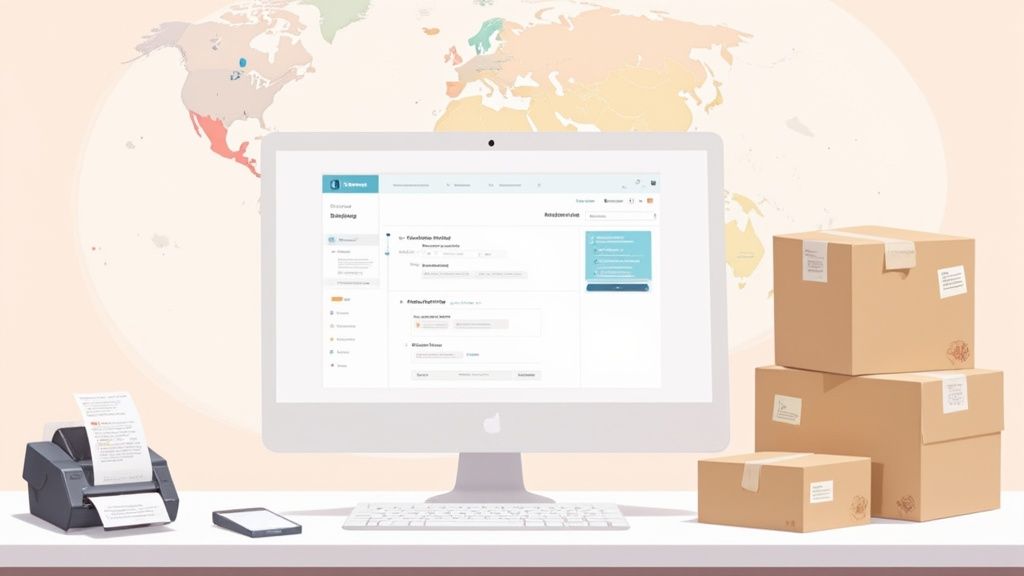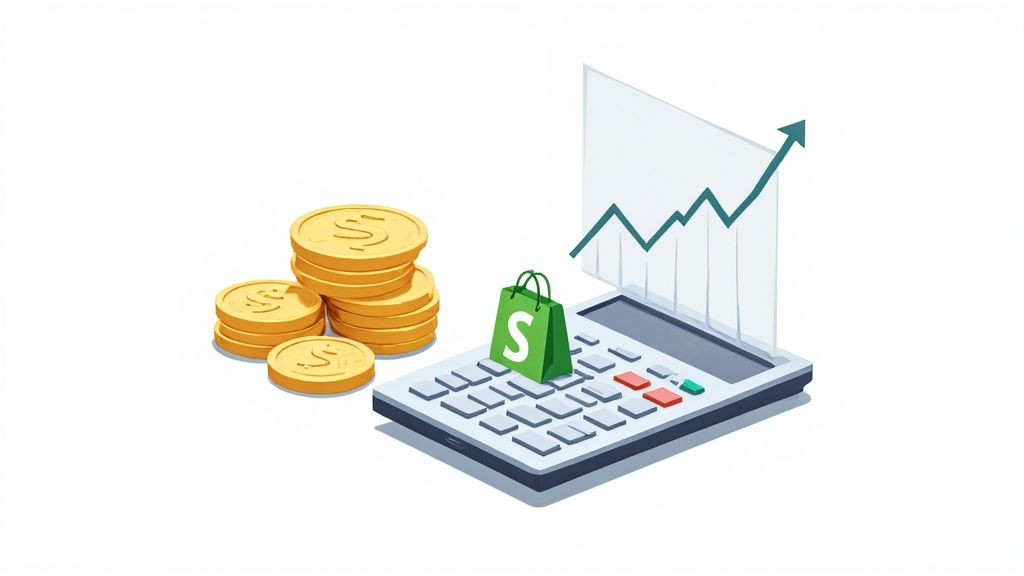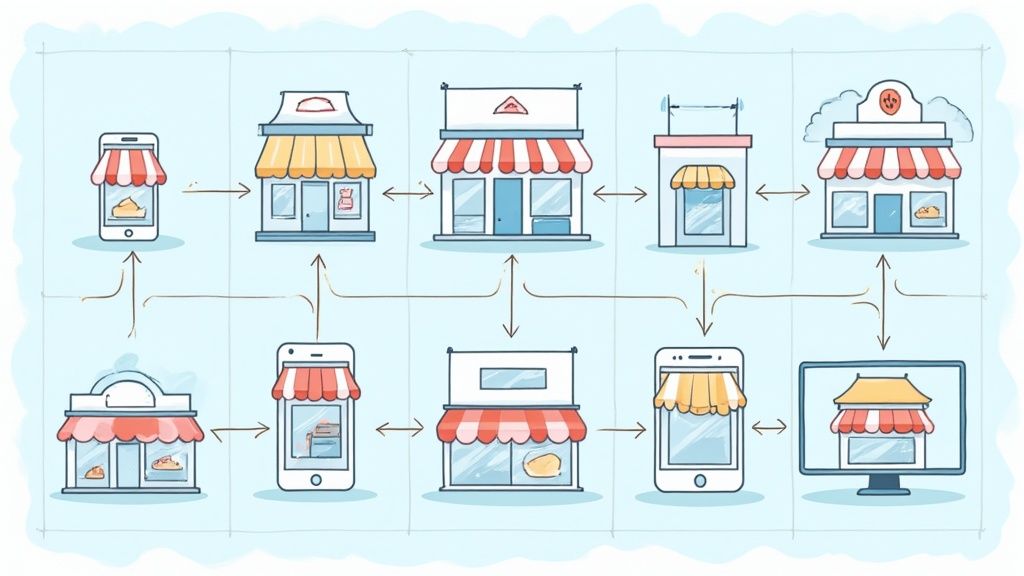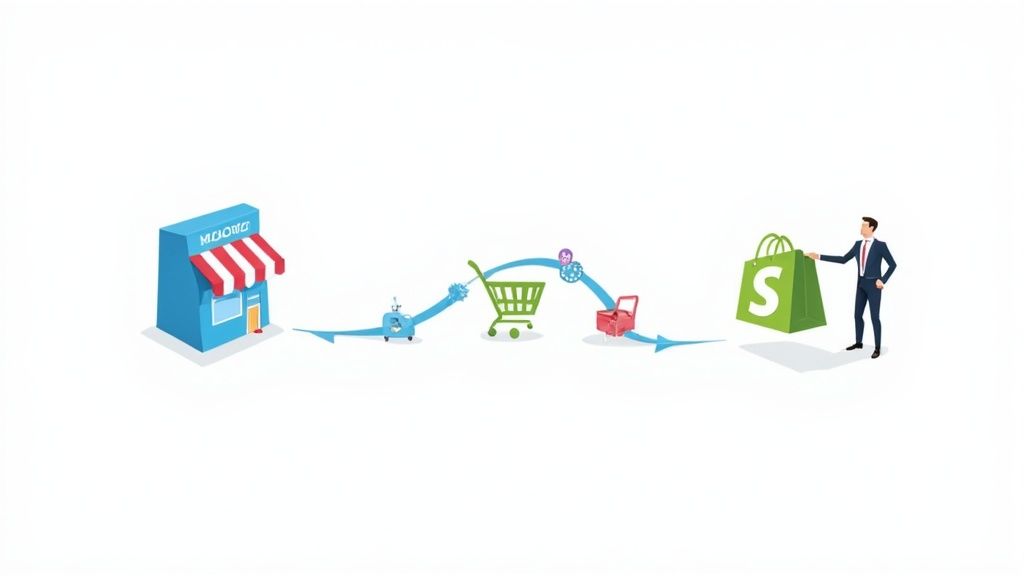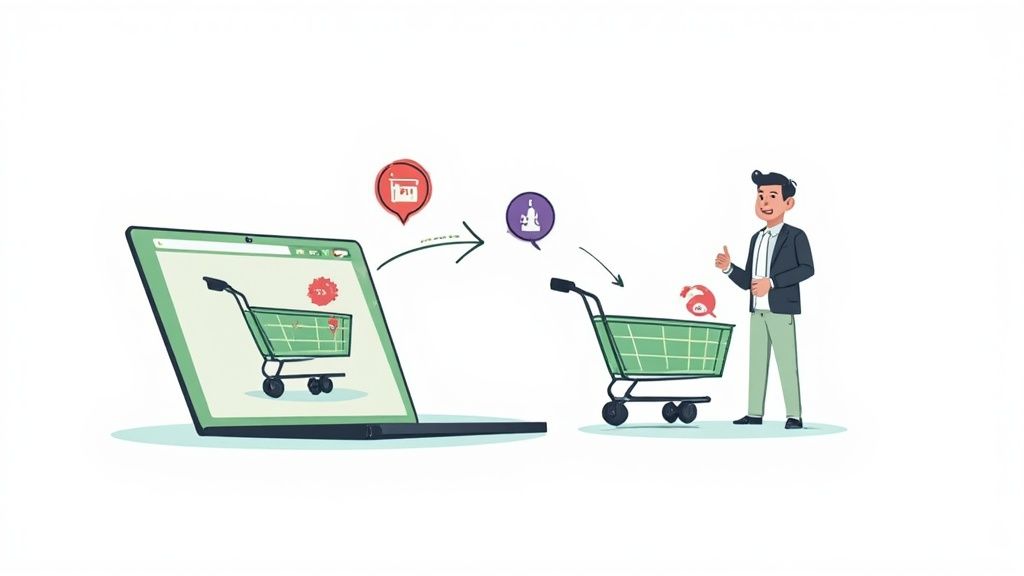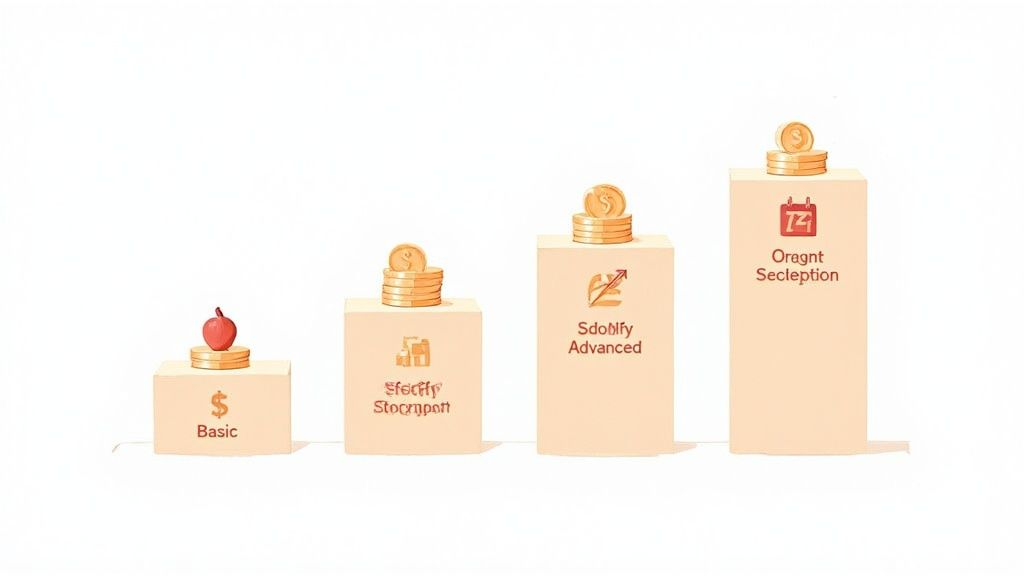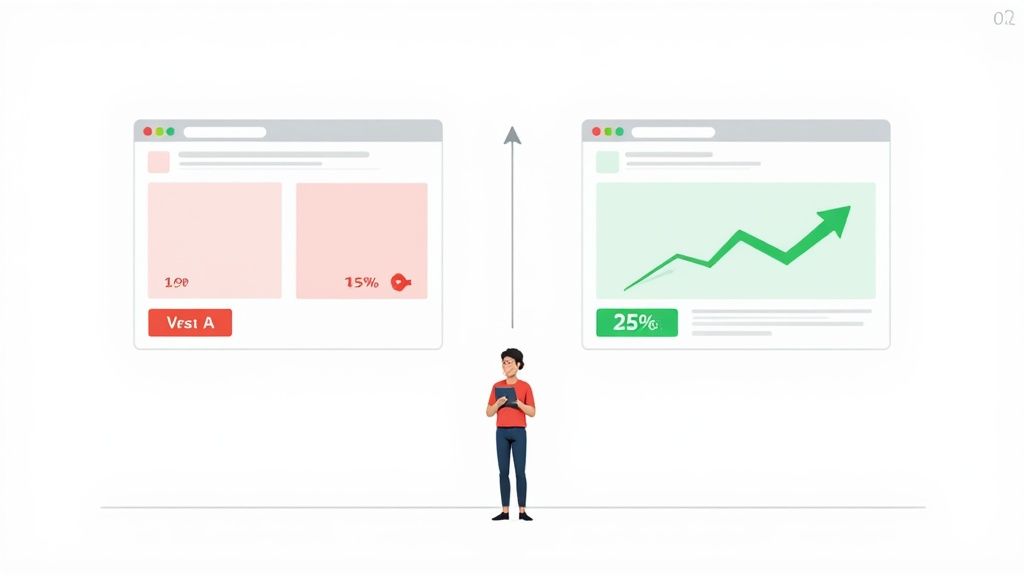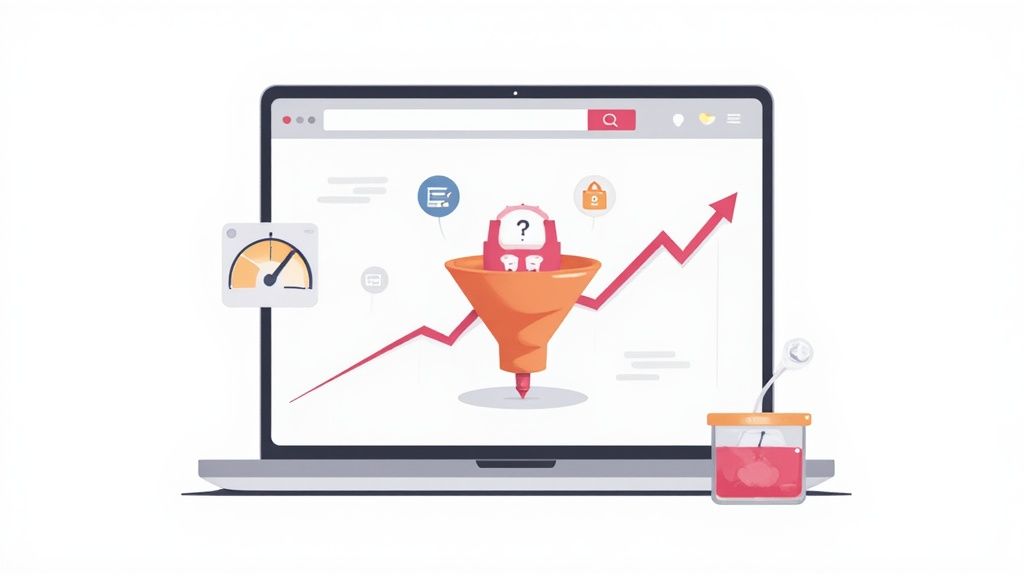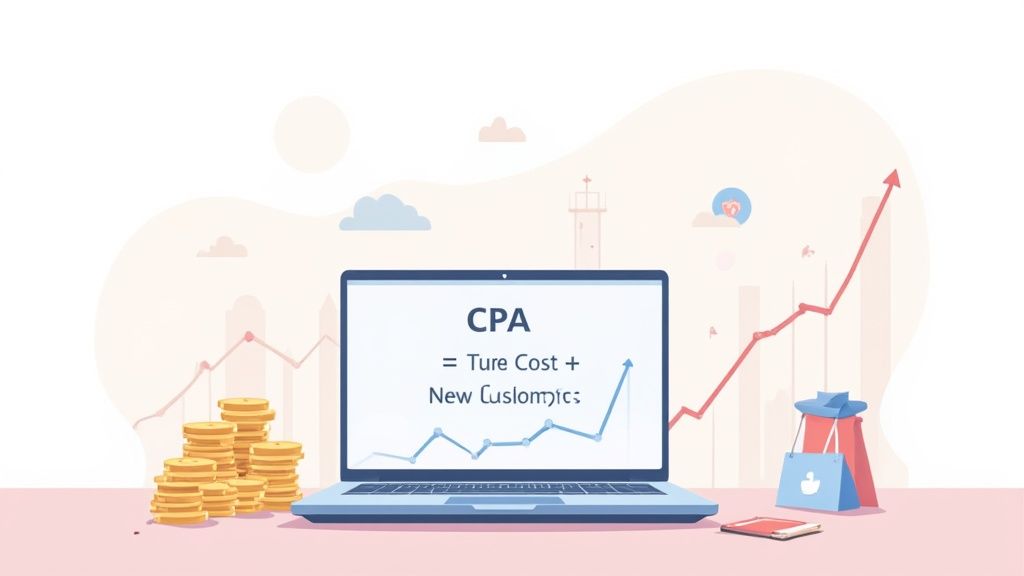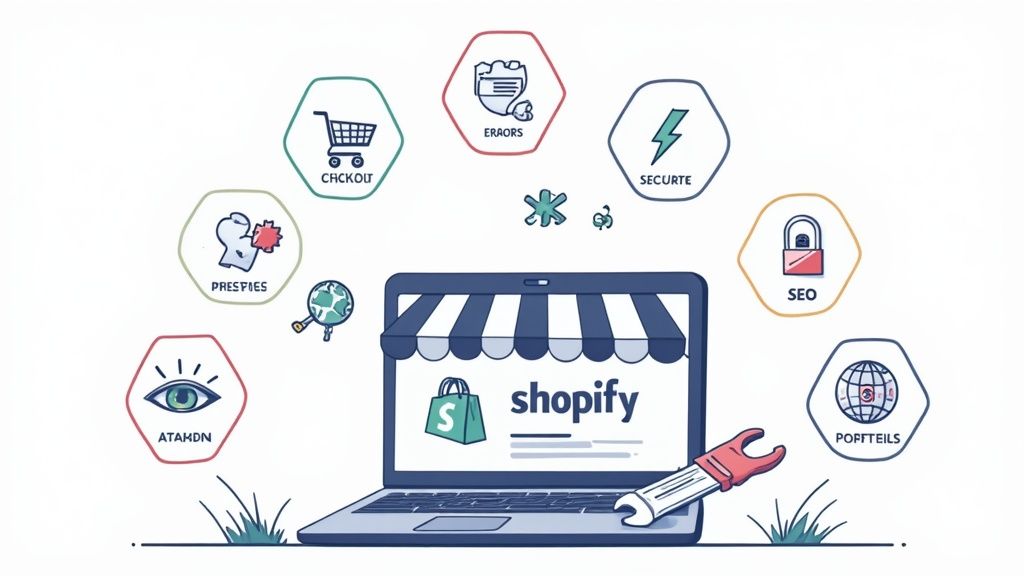
A product roadmap is all about plotting your course. It starts with defining your big-picture strategic vision, then digging into customer and stakeholder insights to figure out what matters most. From there, you prioritize the key initiatives and lay them out on a timeline. Think of it as a living, breathing document that bridges the gap between your lofty goals and the day-to-day work your team needs to tackle.
Why Your Business Needs a Strategic Product Roadmap
A great product roadmap is so much more than a feature list or a project plan—it's your strategic compass for growth.
In the fast-paced world of eCommerce, a clear roadmap isn't just nice to have; it's non-negotiable. It’s what turns vague business goals into a tangible plan of action that gets everyone on the same page, from stakeholders to developers, and ultimately drives real business value.
Without one, teams end up working in silos. Marketing might be prepping a launch for a feature that engineering hasn't even started, all while leadership is scratching their heads, wondering why key business metrics aren't budging. A well-crafted roadmap is your antidote to this chaos.

Core Components of an Effective Roadmap
So, what separates a static, forgotten document from a dynamic strategic tool? The best roadmaps are all about outcomes over outputs. They don't just list features; they explain the "why" behind them, connecting every single initiative back to a customer problem or a business objective.
A truly effective roadmap should always include:
- Vision and Strategy: A clear, concise statement of where the product is heading and how it plans to win.
- Key Themes or Initiatives: High-level areas of focus, like "Improve Mobile Checkout Experience" or "Enhance User Personalization." This is much more effective than a granular list of tiny features.
- Broad Timeframes: Ditch the rigid, specific deadlines. Instead, use flexible timelines like "Now," "Next," and "Later" or quarterly goals (Q1, Q2) to stay agile.
- Success Metrics: This is crucial. How will you measure the impact of your initiatives? Tie the work directly to measurable outcomes like conversion rates, average order value, or customer satisfaction scores.
If you want to go even deeper on the fundamentals, this comprehensive guide to creating an effective product roadmap is a fantastic resource.
A Product Roadmap is the manifestation of your strategy and the guide to its execution. It’s the connective tissue between your vision and the detailed plan, making abstract goals tangible enough for your teams to act upon.
This guide will walk you through the essential phases of building a powerful roadmap—from setting your vision to gathering insights and communicating your plan. It’ll give you a solid mental model to follow as we dive in.
Defining Your Product Vision and Strategic Goals
Before you even think about debating features or sketching out a timeline, your product roadmap needs a north star. A powerful product vision is exactly that—it's the destination that guides every single decision you make. It gets your team excited and, just as importantly, secures buy-in from leadership.
This isn't just some fluffy mission statement. It’s a sharp, inspiring picture of the future you're building for your customers.
A solid vision answers the big "why." Why are we building this? Who are we helping? What specific problem are we solving for them better than anyone else out there? For an eCommerce brand, a vision could be something like, "To become the go-to online destination for sustainably sourced home goods, making ethical shopping effortless for everyone." That's a clear direction.
Turning Vision into Actionable Goals
Once you have that vision locked in, it's time to break it down into real, strategic goals. This is where you connect the company's high-level ambitions to actual product outcomes. Instead of just making a laundry list of features, you focus on delivering measurable impact.
A great way to do this is with a framework like OKRs (Objectives and Key Results).
Let's say a Shopify Plus store's main business objective is to increase customer lifetime value (CLV). A weak product goal would be something generic like "Build a loyalty program." That’s an output, not an outcome.
A much stronger approach? Set a strategic goal like "Enhance post-purchase customer engagement." Now that is directly tied to the business objective. From there, you can set key results to track your progress:
- Increase the repeat purchase rate from 25% to 35% in the next two quarters.
- Boost the average orders per customer from 2.1 to 3.0 within a year.
- Get a 15% adoption rate for a new personalized re-ordering feature.
This forces you to think about the impact first. A loyalty program might be one way to achieve these results, but a new subscription model or better email marketing integrations could also be contenders. The goal drives the feature ideas, not the other way around.
Aligning Stakeholders from the Very Beginning
Getting this level of clarity means you need to get all your stakeholders aligned early on. Your CEO, lead developer, and marketing manager all need to be on the same page about the vision and goals. When they aren't, roadmaps fall apart. Teams pull in different directions, priorities clash, and you end up wasting a ton of time and money.
Run workshops to create the vision and define the OKRs together. This isn't about you telling them what the plan is; it's about building it with them. This collaborative process creates a shared sense of ownership that is absolutely critical. Part of this alignment is having a deep, shared understanding of who you're building for. For a deeper dive on that, check out our guide on how to create buyer personas.
The goal isn't just to get stakeholders to agree with your roadmap. The goal is to build a roadmap they feel they helped create. This collaborative foundation is what turns a document into a shared commitment to a strategic direction.
Gathering Insights and Prioritizing What Matters
A roadmap built on assumptions isn't just a bad plan; it's a direct route to failure. Once you've got your vision locked in, the real work begins. It's time to ground your strategy in reality, which means gathering actual, real-world inputs and making some tough, data-backed calls on what to build next.
Your best ideas won't magically appear in a boardroom meeting. They're already out there, hiding in plain sight. You just need to know where to look. Think of yourself as a detective, digging through the feedback channels that far too many teams completely ignore.
These channels are absolute goldmines. They tell you what your customers actually need, not just what you think they want.
Start your investigation here:
- Customer Support Tickets: What are the most common frustrations your support team is hearing about day in and day out? If you see the same complaints popping up repeatedly, that’s a massive red flag signaling friction in your customer experience.
- Sales Team Notes: What objections or missing features are costing you deals? Your sales crew is on the front lines; they know exactly what prospects are asking for and why they hesitate to buy.
- User Behavior Analytics: Where are people dropping off in your Shopify store? Tools that show heatmaps or session recordings can reveal user behavior that you’d never uncover through surveys or direct feedback. It's the unspoken truth.
Beyond your own internal data, you have to look outward. Understanding where you stand in the market is just as critical. Actively monitoring market visibility and competitive landscape will shine a light on opportunities or threats you might have otherwise missed.
This whole process is about connecting the dots—seeing how your big-picture vision can be broken down into actionable goals that eventually become tangible features.

This flow, from a broad vision all the way down to specific, measurable outcomes, is what ensures every single thing you build has a clear purpose tied directly to the success of your business.
Using Frameworks to Prioritize with Objectivity
After you've gathered all this feedback and data, you're going to be staring at a mountain of ideas. Now for the hard part: deciding what to tackle first. This is exactly where prioritization frameworks come in, bringing much-needed objectivity to the chaos and shifting the conversation from gut feelings to structured, logical decision-making.
There are a ton of frameworks out there, but some of the most popular and effective models provide a systematic way to evaluate and compare different initiatives. They give you a common language to discuss trade-offs and make sure everyone is looking at the options through the same lens.
Comparing Popular Roadmap Prioritization Frameworks
Choosing the right framework can feel overwhelming, but it's really about finding the one that best aligns with your team's culture and the current stage of your product. Here’s a quick breakdown of a few common models to help you see how they stack up.
Let's walk through a real-world scenario for a Shopify store to see how this works in practice. Imagine you're debating between two big ideas:
- AI-Powered Search: A technically complex, high-effort project that could have a huge impact.
- Improved Mobile Checkout: A much lower-effort fix for a known conversion-killer on mobile devices.
If we use the RICE framework (Reach, Impact, Confidence, Effort), we can score each one. The AI search might have a massive potential Impact, but the Effort required is enormous, and your Confidence in getting it right on the first try is probably moderate at best.
A prioritization framework doesn't make the decision for you. It just gives your team a shared language and a consistent lens to evaluate options. It forces everyone to justify their choices with data, not just defend their pet projects.
On the other hand, fixing the mobile checkout has a smaller but almost guaranteed Impact on conversions. It reaches every single mobile user (Reach), requires far less Effort, and your Confidence in its success is nearly 100%.
Suddenly, the choice is clear. The mobile checkout improvement is the obvious quick win. It delivers immediate, measurable value and solves a proven customer pain point. This kind of systematic thinking is the bedrock of a product roadmap that actually delivers results.
Choosing the Right Tools to Build Your Roadmap
Once your strategy is nailed down and you know your priorities, it's time to pick the right software to bring your roadmap to life. A simple spreadsheet might get you off the ground, but as your Shopify business scales, you'll need a dedicated tool. This isn't just about making a static document—it's about creating a dynamic, collaborative plan.
The goal here isn't just to find a tool that makes a pretty timeline. You're looking for a single source of truth that keeps everyone, from marketing to engineering, perfectly aligned and moving in the same direction.
Key Features to Look For in Roadmap Software
When you start looking at different platforms, a few features are absolute must-haves for any modern product team. These are the things that make a roadmap a living, breathing part of your workflow instead of a file that just collects digital dust.
Here's what I always look for:
- Real-Time Updates: The tool has to show changes instantly. If the plan shifts, everyone needs to see it immediately, ensuring the roadmap is always the current source of truth.
- Customizable Views: Your CEO doesn't need to see the nitty-gritty details, but your engineering team absolutely does. The best tools let you toggle between a high-level overview and a granular, task-oriented view using the same data.
- Critical Integrations: It's essential that your roadmap tool talks to your project management software. A seamless connection with tools like Jira or Asana bridges the gap between high-level strategy and the actual day-to-day work your developers are tackling. We talk more about this in our guide to building the perfect eCommerce tech stack.
Here’s a quick look at how a tool like Jira can visualize a roadmap, connecting big-picture initiatives to a clear timeline.

This kind of visual layout makes it incredibly easy to spot dependencies and show stakeholders where things stand with just a quick glance.
The best roadmap tool is the one your team will actually use. Focus on simplicity, powerful integrations, and the ability to communicate the 'why' behind your plan, not just the 'what' and 'when'.
The Evolution Toward Data-Driven Roadmapping
The growing demand for these sophisticated tools points to a huge shift in how product planning gets done. The global product roadmap software market was valued at around USD 1.5 billion in 2023 and is expected to more than double by 2032. You can dig into more insights about this growing market on dataintelo.com. This explosive growth really highlights how critical structured, tool-based planning has become for any serious business.
We're also seeing a move away from gut-feel roadmapping. Many modern platforms now use AI to help with forecasting or even suggest priorities based on historical data and business goals. This is pushing roadmapping from a purely manual task to a much more dynamic, data-informed strategic function.
Ultimately, choosing your software isn't just an operational decision; it's a strategic one that gives your team the power to build better products, faster.
Getting Your Roadmap Out There and Keeping It Alive
Look, creating a product roadmap is a massive achievement. Pop the champagne. But its real power isn't unlocked until it becomes a living, breathing part of your team's day-to-day. A roadmap that just collects dust in a forgotten Google Drive folder is completely useless. Its value comes from constant communication and a willingness to tweak it as you learn more.
How you talk about your roadmap has to change depending on who's in the room. You've got to spin the narrative to focus on what each group actually cares about.
An executive briefing, for example, shouldn't get bogged down in the nitty-gritty technical specs. Nobody cares. Instead, you need to hit the high notes: broad themes, expected business impact, and how the plan directly fuels the company's biggest goals.
But when you're sharing the roadmap with your dev team, that's when you dive deep. This is where you connect those big strategic themes to the actual epics and user stories piling up in their backlog. The whole point is to give them the why behind the work—it's a huge motivator and helps them make smarter technical calls along the way.
Setting a Rhythm for Reviews and Changes
A static roadmap is a dead roadmap. Simple as that. The market will inevitably shift, new customer feedback will pour in, and shiny new opportunities will pop out of nowhere. To stay on your toes, you need a regular schedule for checking in and updating the plan.
For most eCommerce brands, a quarterly review is the sweet spot.
This cadence gives your team enough runway to make real, tangible progress on initiatives without being so infrequent that you can't react to change. These quarterly check-ins are absolutely vital. Use them to:
- Check progress against the current quarter's goals. Are we on track?
- Validate priorities for the next quarter based on fresh data and insights.
- Realign everyone from marketing to ops to make sure you're all still rowing in the same direction.
- Make the tough calls. Sometimes you have to pivot or even kill initiatives that just aren't relevant anymore.
This process ensures your roadmap stays a strategic guide, not a rigid set of instructions forcing you down the wrong path.
Your product roadmap isn't a contract set in stone; it's a compass. It provides direction, but you must be willing to adjust your course based on the terrain you encounter.
Always Tie It Back to Your North Star
Want to build trust and make sure the roadmap is seen as a strategic tool? Every single item on it needs to be traceable back to a specific piece of customer feedback or a hard business metric.
This one practice changes the entire conversation. You move away from subjective debates about which feature is "cooler" and into objective discussions about impact.
For example, don't just say, "We're building a new product recommendation engine."
Instead, frame it like this: "We're launching a personalized recommendation engine to increase our Average Order Value by 15%, based on user feedback requesting more tailored shopping experiences."
See the difference? This simple shift constantly reminds everyone why they're building what they're building. The product roadmap software market has caught on, with many tools now offering features like real-time co-editing and built-in communication to keep teams on the same page. You can find more insights on these advanced software capabilities over at datainsightsmarket.com.
When you make your roadmap a dynamic, collaborative document, you guarantee it remains a powerful tool for pushing your business forward.
Still Have Questions About Product Roadmaps?
Even with the best guide in hand, putting a product roadmap into practice for the first time can feel a bit murky. When you're trying to juggle stakeholder demands, customer feedback, and the realities of your dev team's capacity, a few common roadblocks always seem to pop up.
Let's clear the air on some of the most frequent questions I hear from product managers. Nailing these distinctions can be the difference between a roadmap that gathers dust and one that actually drives your business forward.
How Is a Product Roadmap Different from a Release Plan?
This is, hands down, the most common point of confusion. The simplest way to think about it is strategy vs. tactics.
Your product roadmap is all about the "why." It's your high-level, strategic vision, outlining the big themes and customer problems you’re aiming to solve over the next few quarters or even the year. It’s about the destination and the desired outcomes. A theme on your roadmap might be something like, "Streamline the Mobile Checkout Experience."
A release plan, on the other hand, is the tactical "what" and "when." It breaks down the immediate journey. This document gets into the nitty-gritty of an upcoming launch, detailing the specific features, user stories, and timelines your team needs to ship the next product update. It’s what fuels sprint planning. The roadmap sets the direction; the release plan maps out the next few steps.
How Much Detail Should I Put in My Roadmap?
Ah, the age-old question. Finding the right level of detail is more of an art than a science, but the golden rule is to match the detail to your audience. If your roadmap looks like a giant to-do list of features, bug fixes, and technical tasks, you've gone too far.
A product roadmap is a strategic communication tool, not a project management backlog. Its job is to get everyone aligned on the why, not to track every single task. Keep it high-level to keep it strategic.
When you're presenting to executives, you want to stick to broad themes and the business outcomes you expect. Connect your initiatives directly to top-line metrics they care about, like revenue growth or customer retention.
For your development team, you can add a bit more flavor by linking those themes to specific epics in your backlog. The trick is to provide context without getting lost in the weeds of implementation details.
Should My Roadmap Have Hard Deadlines?
It's so tempting to slap specific dates on a roadmap. It feels concrete, and stakeholders love it. But trust me, it’s almost always a bad idea. Avoid hard deadlines like the plague.
Locking in specific dates turns your roadmap into a rigid, waterfall-style contract. It completely sucks the agility out of your process. The moment a date inevitably slips—and it will—trust in the entire roadmap begins to crumble. It stops being a flexible guide and becomes a document that’s perpetually "wrong."
Instead, focus on communicating priority and sequence using broader time horizons. This is why so many product teams now use a simple, powerful format:
- Now: What we’re actively building at this moment.
- Next: What’s teed up and coming in the near future.
- Later: Important initiatives that are on our radar but further out.
Another great approach is to organize your roadmap by quarters (e.g., Q1, Q2, Q3). This gives a clear sense of timing and priority without the crushing pressure of a specific "due by" date. It gives your team the breathing room they need to learn, adapt, and build amazing products.
Ready to turn your strategic vision into a high-converting reality? The team at ECORN specializes in Shopify development and conversion rate optimization to bring your product roadmap to life. Let's build your next big thing together.













